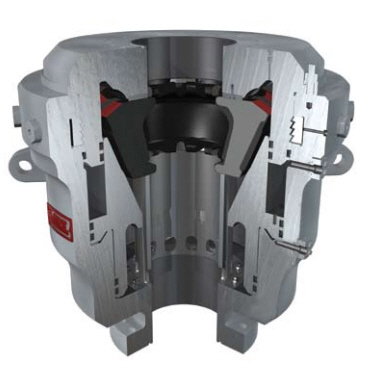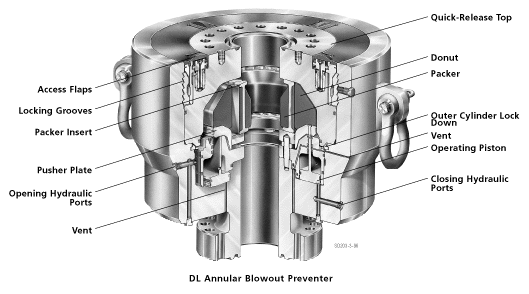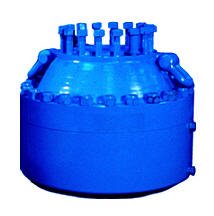Annular preventers are the most versatile well control equipment and there are many names referring it as bag preventers, or spherical preventers. The annular preventers are able to seal around several size of drill pipe/drill collar, work string, wireline, tubing, etc. There are some models which can utilize wellbore pressure to provide additional sealing capability.
The annular preventer consists of a body, a cap, a piston and a rubber packing element. The illustration below demonstrates the drawing of an annular preventer.

How the annular preventers work?
Close - When the hydraulic oil is pumped into the extend port, the element inside will be lifted and squeezed the pipe/tubular.

Open - On the other hand, if the hydraulic fluid is pumped into the retract port, the element will be pushed down resulting in releasing the tubular.

Nowadays, there are several manufactures providing this equipment such as Hydril, NOV (Shaffer) and Cameron. The models available in the market based on the manufactures are listed below:
Hydril – Hydril GL, GX, GK and Annu-Flex
 Hydril GL
Hydril GL http://hydrilpressurecontrol.com/pressureControl/BOP/annulars/annular-GL.php
 Hydril GK
Hydril GK http://hydrilpressurecontrol.com/pressureControl/BOP/annulars/annular-GK.php
 Hydril Gx
Hydril Gx http://hydrilpressurecontrol.com/pressureControl/BOP/annulars/annular-GX.php
 Hydril Anuflex
Hydril Anuflex http://hydrilpressurecontrol.com/pressureControl/BOP/annulars/annular-Annuflex.php
Cameron – Cameron DL
 Cameron DL
Cameron DL http://www.c-a-m.com/forms/Product.aspx?prodID=ecd6ef4e-19dc-4ea9-ad47-94689e36b61c
NOV (Shaffer) – SPHERICAL BOPS
 SPHERICAL BOPS
SPHERICAL BOPS http://www.nov.com/Drilling/Drilling_Pressure_Control/Blowout_Preventers/Spherical_BOPs.aspx
In the market, the annular preventers have wide range of size and operating pressure and you can see from the technical specification from the link that we provide. It is very important that personnel must know how to operate and maintenance the annular preventers properly. Personnel must strictly follow the operating manual to prevent the premature failure.




No comments:
Post a Comment